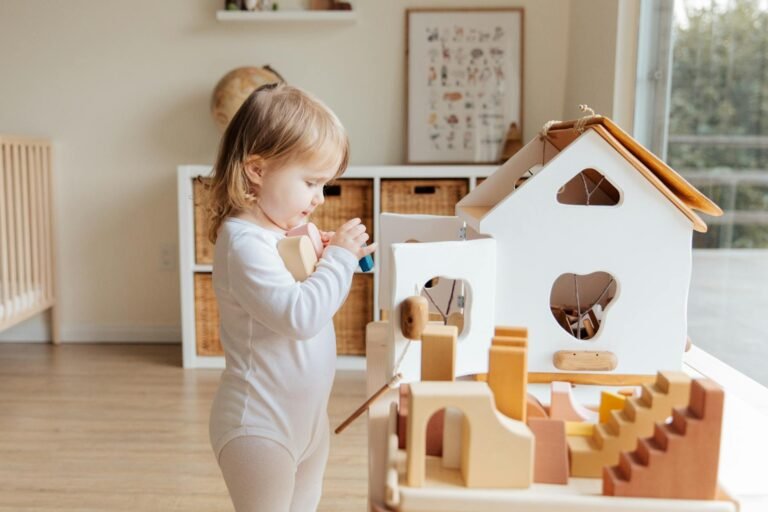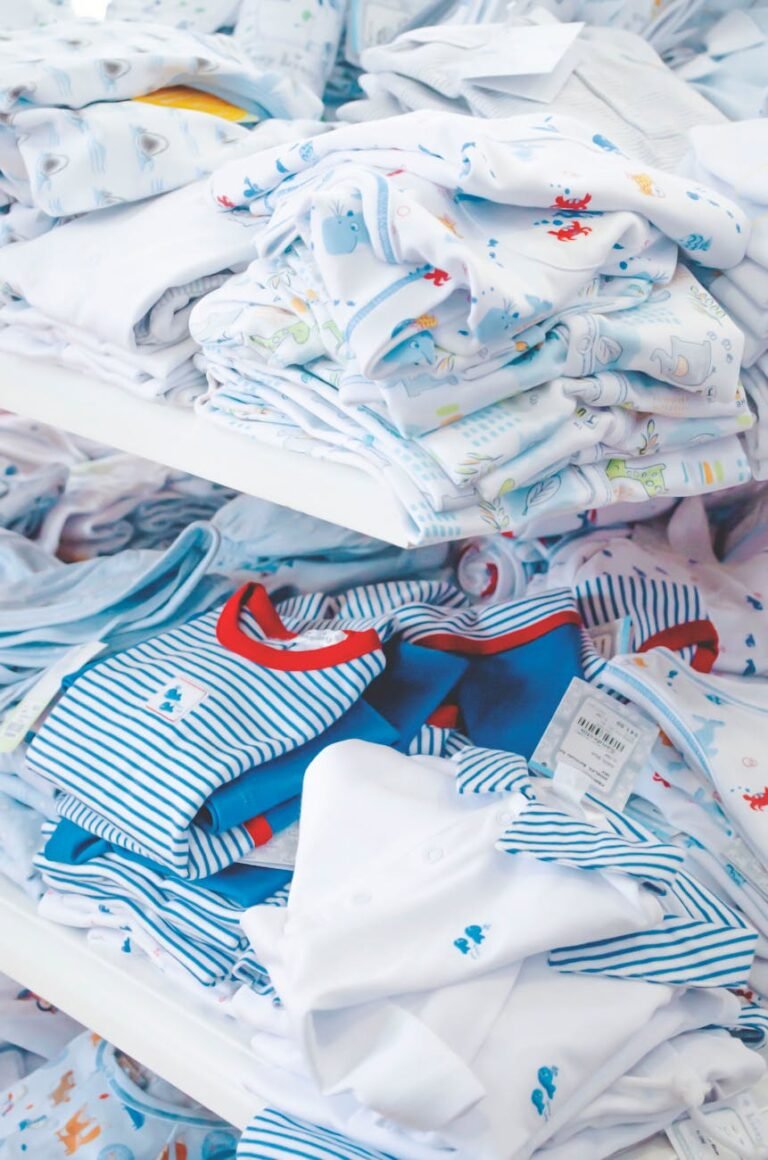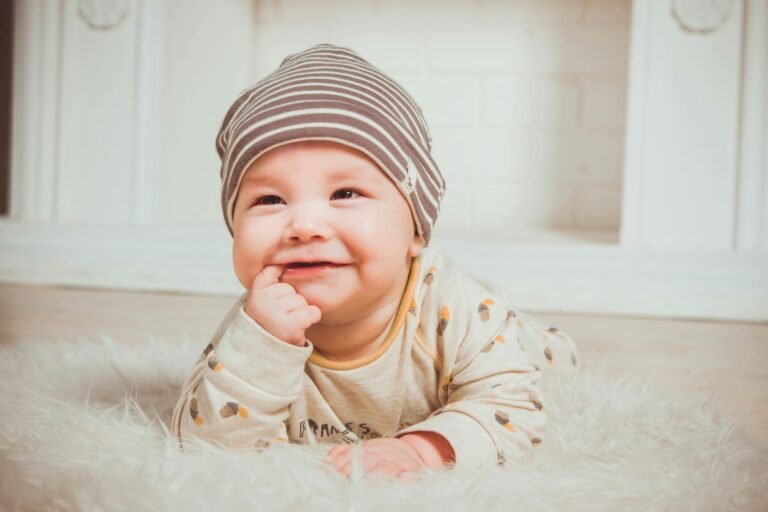Ever felt like picking the right baby clothes size is a puzzle? Our baby clothes guide helps you through it. Knowing the right sizes is key for your baby’s comfort and for clothes to last longer.
Newborn clothes are labeled as NB, while infant clothes have month markers (like 0-3M). Toddler clothes show the age (like 2T). Remember, sizes differ across brands, so knowing your brand’s size chart is vital. Many babies wear newborn clothes until their third month.
We’ll explore age, weight, and length in sizing. This guide will help you understand baby clothes sizing standards. Whether you’re starting your baby’s wardrobe or need shopping tips, we’re here to help!
Key Takeaways
- Understanding baby clothes sizing is crucial for ensuring comfort and durability.
- Baby apparel sizing often varies by brand, making brand-specific size charts important.
- Age-based and weight-based sizing both play significant roles in choosing the right fit.
- Knowledge of fabric types and growth rates can aid in making better shopping decisions.
- Ensuring your baby’s comfort involves considering multiple factors, from size to fabric.
How Baby Clothes Sizes Work
Knowing how baby clothes sizes work is key for your little one’s comfort and style. Unlike adult clothes, baby sizes change fast because babies grow quickly. It’s crucial to understand these sizes to avoid buying clothes that are too big or too small.
Age-Based Sizing
Age-based sizing is a common method, with sizes from newborn to 24 months and beyond. Newborn clothes are marked as NB. Infant clothes are labeled by month (e.g., 0-3M), and toddler clothes by age (e.g., 2T).
- Newborn (NB): Ideal for babies weighing 5-8 lbs.
- 0-3M: Fits babies between 8-12 lbs.
- 0-6M: Suitable for weights up to 16 lbs.
- 3-6M: Designed for 12-16 lbs.
- 6-9M: Perfect for 16-20 lbs.
- 12M: Recommended for 20-24 lbs.
- 18M: Tailored for 24-28 lbs.
- 24M / 2T: Fits 28-32 lbs., with 2T aimed at potty-trained toddlers.
But, age-based sizing may not fit every baby perfectly. Some parents use weight-based sizes and length to get a better fit.
Weight and Length Considerations
While age-based sizing is a starting point, weight and length can offer a more precise fit. Here’s a quick overview:
| Size | Weight | Length |
|---|---|---|
| Preemie | Up to 5 lbs. | Up to 17 in. |
| Newborn (NB) | 5-8 lbs. | 17-21 in. |
| 0-3M | 8-12 lbs. | 21-24 in. |
| 3-6M | 12-16 lbs. | 24-26 in. |
| 6-9M | 16-20 lbs. | 26-28 in. |
| 12M | 20-24 lbs. | 28-30 in. |
| 18M | 24-28 lbs. | 30-32 in. |
| 24M / 2T | 28-32 lbs. | 32-34 in. |
| 3T | 32-35 lbs. | 34-38 in. |
| 4T | 35-39 lbs. | 38-40 in. |
| 5T | 39-43 lbs. | 40-44 in. |
Understanding baby clothes sizing by age, weight, and length helps parents predict their child’s needs. This knowledge makes organizing a baby’s wardrobe easier, ensuring every outfit is both comfortable and functional.
Baby Clothes Size Chart
A baby size chart is key for finding the right fit for your baby. It shows how age, weight, and length relate. This helps parents pick the best clothes for their little ones.
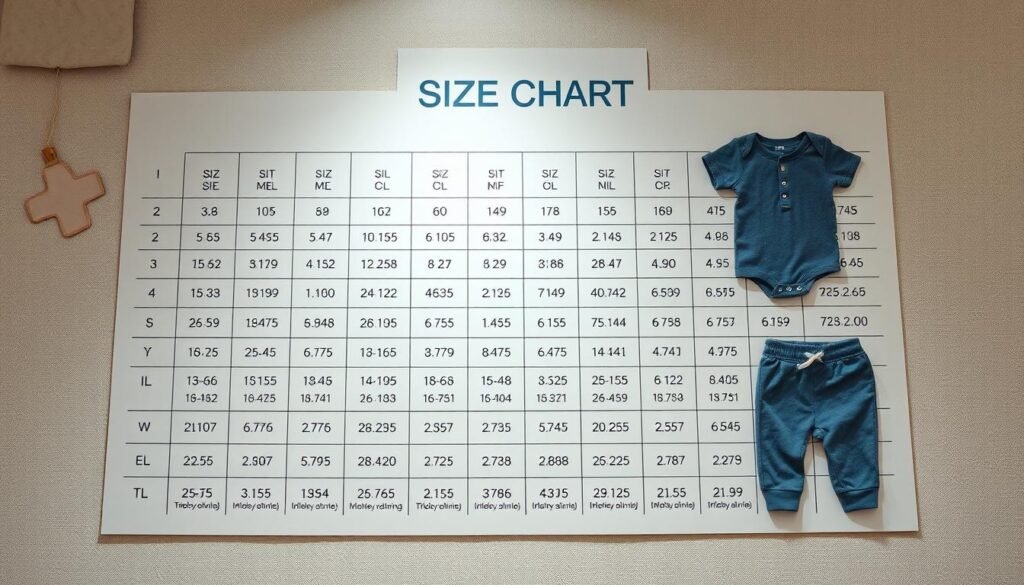
Using the Size Chart Effectively
Using a baby size chart well makes finding clothes easier. Here’s how to do it:
- Identify your baby’s current measurements: Keep track of their weight and length.
- Match their stats to the size chart: Use these numbers to find the right size for your baby.
- Consider future growth: Babies grow fast, so pick sizes that will fit as they grow.
- Account for diaper space: Make sure clothes have enough room for diapers up to 24 months.
Brand-Specific Variations
It’s important to know that brand sizing differences can affect how clothes fit. Brands use different standards for their sizes. For example:
- Gerber: Gerber 0-3 month sizes fit babies weighing 8-12 pounds and measuring 21-24 inches.
- Carters: Carters 3-month clothes fit babies weighing 9-12.5 pounds and measuring 21.5-24 inches. Their 6-month clothes are for babies weighing 12.5-17 pounds and measuring 24-27 inches.
- Baby Gap: Baby Gap’s 3-6 month size fits babies weighing 12-17 pounds and measuring 23-27 inches.
- Amazon Essentials: Amazon Essentials 0-3 month clothes are for babies weighing 9-12.5 pounds and measuring 21.5-24 inches.
Because of these differences, always check your baby’s measurements against each brand’s size chart.
How Does Baby Clothes Sizing Work
Finding the right fit for baby clothes can be tricky. This is because sizing standards vary worldwide and differ between brands. In the U.S., sizes like ‘Preemie,’ ‘Newborn,’ and ‘3 months’ or ‘6 months’ are used. These sizes match specific weight and height ranges.
Common Sizing Standards
Knowing the standard sizes for baby clothes is key for a good fit and comfort. Here are the common sizes:
- Preemie: For babies up to 5 lbs (2.3 kg) and 17 in. (43.2 cm).
- Newborn (NB): Fits babies between 5-8 lbs (2.3-3.6 kg) and 17-21 in. (43.2-53.3 cm).
- 0-3 Months: Suitable for babies weighing 8-12 lbs (3.6-5.4 kg) and measuring 21-24 in. (53.3-61 cm).
- 3-6 Months: For babies weighing 12-16 lbs (5.4-7.3 kg) and between 24-26 in. (61-66 cm).
- 6-9 Months: Accommodates babies weighing 16-20 lbs (7.3-9.1 kg) and measuring 26-28 in. (66-71.1 cm).
- 12 Months: Suits babies weighing 20-24 lbs (9.1-10.9 kg) and 28-30 in. (71.1-76.2 cm).
- 18 Months: For babies weighing 24-28 lbs (10.9-12.7 kg) and measuring 30-32 in. (76.2-81.3 cm).
- 24 Months / 2T: Fits toddlers weighing 28-32 lbs (12.7-14.5 kg) and measuring 32-34 in. (81.3-86.4 cm).
These sizes are designed to keep up with a baby’s growth. But, every baby is different, so the fit might not always be perfect.
| Size | Weight | Height |
|---|---|---|
| Preemie | up to 5 lbs | up to 17 in. |
| NB | 5-8 lbs | 17-21 in. |
| 0-3M | 8-12 lbs | 21-24 in. |
| 3-6M | 12-16 lbs | 24-26 in. |
| 6-9M | 16-20 lbs | 26-28 in. |
| 12M | 20-24 lbs | 28-30 in. |
| 18M | 24-28 lbs | 30-32 in. |
| 24M / 2T | 28-32 lbs | 32-34 in. |
Since newborn sizes can change a lot between brands, it’s smart to track your baby’s weight and height. This helps you pick the most comfortable size for them.
Newborn Baby Clothes Sizes
Newborn baby clothes sizes can change a lot. It’s key to know these changes for a comfy fit. In the first weeks, babies wear clothes labeled as NB (newborn). These are for babies weighing 5-8 lbs. and 17-21 in. tall.
But, many babies grow out of these sizes fast. This means they need to switch to 0-3 months clothes quickly.
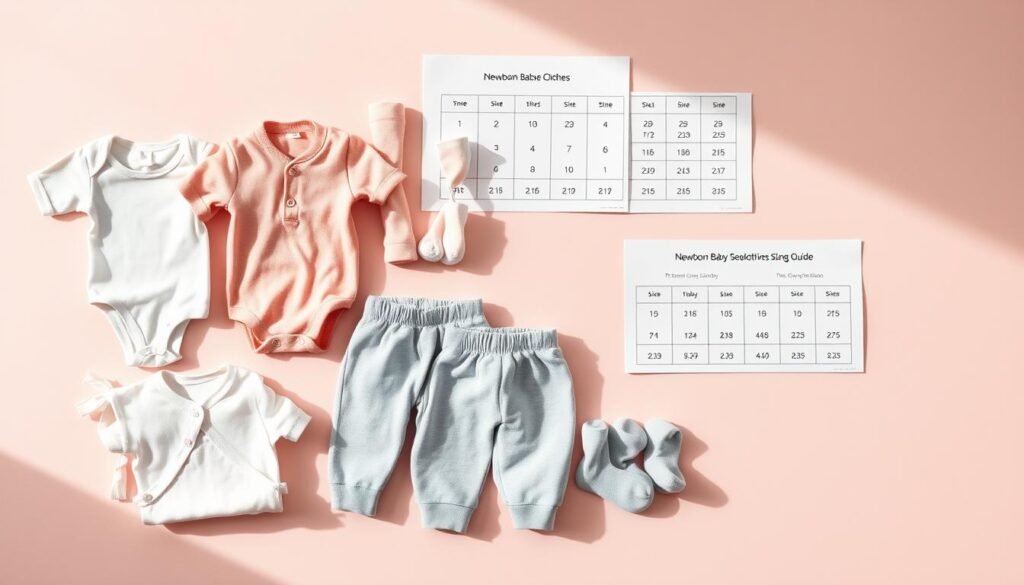
Knowing the newborn sizing guide is very important. For example, first size baby clothes fit babies up to 8 lbs. On the other hand, 0-3 months clothes fit babies 8-12 lbs. and 21-24 inches tall. Here’s a detailed overview to help you navigate through the various sizes:
| Size | Weight (lbs) | Height (in) |
|---|---|---|
| Newborn | 5-8 | 17-21 |
| 0-3 Months | 8-12 | 21-24 |
| 3-6 Months | 12-16 | 23-26 |
| 6-9 Months | 16-20 | 26-28 |
| 9-12 Months | 20-24 | 28-30 |
Babies grow fast, gaining 7 ounces and growing ½ to 1 inch every week in the first six months. This means parents need to have different sizes ready. By their first birthday, babies often triple their birth weight, making sizing even more complex.
In summary, while first size baby clothes are great for the start, moving to 0-3 months clothes is wise. This ensures a comfy fit as your baby grows. Always check a reliable newborn sizing guide and have various sizes ready for your growing baby!
Baby Clothes Sizes by Weight
Knowing about weight-based clothing sizes is key for dressing your baby. Sizes like “Preemie” or “Newborn” match certain weight ranges, not just age. This method helps ensure a good fit as babies grow fast.
Preemie to 24 Months
The smallest size, preemie sizes, fits babies up to 5 lbs. (2.3 kg) and 17 in. (43.2 cm). Sizes go up to 24 months, covering different weight ranges. It’s important for brands and parents to know this.
| Size | Weight | Height |
|---|---|---|
| Preemie | up to 5 lbs (2.3 kg) | up to 17 in (43.2 cm) |
| Newborn | 5-8 lbs (2.3-3.6 kg) | 17-21 in (43.2-53.3 cm) |
| 0-3M | 8-12 lbs (3.6-5.4 kg) | 21-24 in (53.3-61 cm) |
| 3-6M | 12-16 lbs (5.4-7.3 kg) | 24-26 in (61-66 cm) |
| 6-9M | 16-20 lbs (7.3-9.1 kg) | 26-28 in (66-71.1 cm) |
| 12M | 20-24 lbs (9.1-10.9 kg) | 28-30 in (71.1-76.2 cm) |
| 18M | 24-28 lbs (10.9-12.7 kg) | 30-32 in (76.2-81.3 cm) |
| 24M / 2T | 28-32 lbs (12.7-14.5 kg) | 32-34 in (81.3-86.4 cm) |
Infant to Toddler Sizes
After the first year, picking clothes gets more detailed. Weight-based sizes are key. Sizes go from 2T to 5T, fitting toddlers from 28 to 43 lbs. (12.7-19.5 kg). This helps with the quick growth of young children.
| Size | Weight | Height |
|---|---|---|
| 3T | 32-35 lbs (14.5-15.9 kg) | 34-38 in (86.4-96.5 cm) |
| 4T | 35-39 lbs (15.9-17.7 kg) | 38-40 in (96.5-101.6 cm) |
| 5T | 39-43 lbs (17.7-19.5 kg) | 40-44 in (101.6-111.8 cm) |
Knowing toddler clothes sizing makes shopping easier. It also ensures your toddler stays comfortable and fits well. Working with reliable makers is crucial for brands.
Choosing the Right Size for Your Baby
Choosing the right size for your baby can be hard. It involves knowing how brands differ, watching your baby grow, and making sure they’re comfortable. Babies grow fast, about 1 inch a month in the first year. This means their clothes size changes a lot.
Factors to Consider
There are key things to think about when picking out clothes for your baby:
- Growth Rate: Babies grow at different speeds. Newborn clothes fit babies weighing 5 to 9 pounds. It’s wise to have a few extra sizes to last longer.
- Brand Variations: Most parents notice big size differences between brands. This makes picking the right size harder.
- Type of Clothing: Different clothes fit differently. For example, stretchy onesies grow with your baby better than stiff clothes.
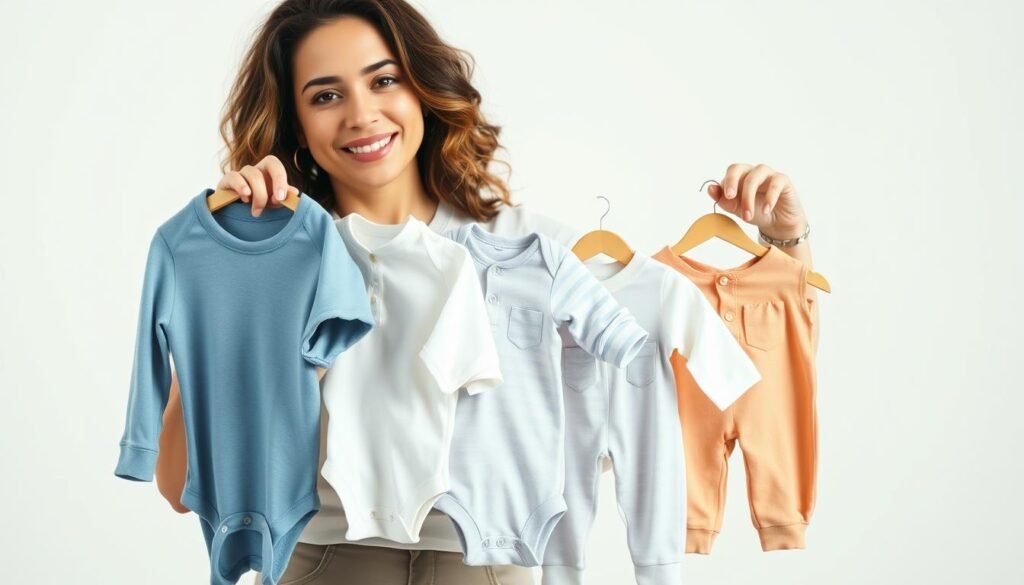
Trial and Error Adjustments
Trying different sizes is sometimes needed to find the right fit. Here’s why:
- Frequent Checks: Babies grow a lot in the first six months. You’ll need to check their size often.
- Comfort First: Many parents choose bigger sizes for comfort. This makes their baby happy.
- Online Charts: Some parents use online size charts. But these can be wrong, leading to returns.
Being open and flexible helps you find the right clothes for your baby. Making changes often keeps your baby comfortable and happy.
Understanding European Baby Clothes Sizes
Dressing babies right means knowing the difference between European and U.S. sizes. European sizes are in centimeters, showing the baby’s length. This is different from U.S. sizes, which use age, weight, and height.
Conversion Guide
Here’s a simple guide to help pick the right size. Knowing the difference between U.S. and European sizes is key. For example, sizes 60, 70, and 80 in Europe match different U.S. age ranges. Here’s a chart to help you:
| European Size (cm) | U.S. Size | Weight | Height |
|---|---|---|---|
| 60 | 3-6M | 12-16 lbs. | 24-26 in. |
| 70 | 6-12M | 16-20 lbs. | 26-28 in. |
| 80 | 12-18M | 20-24 lbs. | 28-30 in. |
| 90 | 18-24M | 24-28 lbs. | 30-32 in. |
Differences from U.S. Sizes
European sizes use length, unlike U.S. sizes. Brands like H&M and Zara follow these centimeter sizes. This method is more precise than age-based sizes. But, it means you need to check size charts and convert sizes often.
It’s important to know these differences to ensure a good fit. By using size conversion guides and understanding European sizes, you can dress your baby well. This applies to clothes from both Europe and the U.S.
Shopping Tips for Baby Clothes
Shopping for baby clothes can be fun. Knowing the difference between in-store and online shopping helps a lot. You can try clothes on in stores or find more choices online.
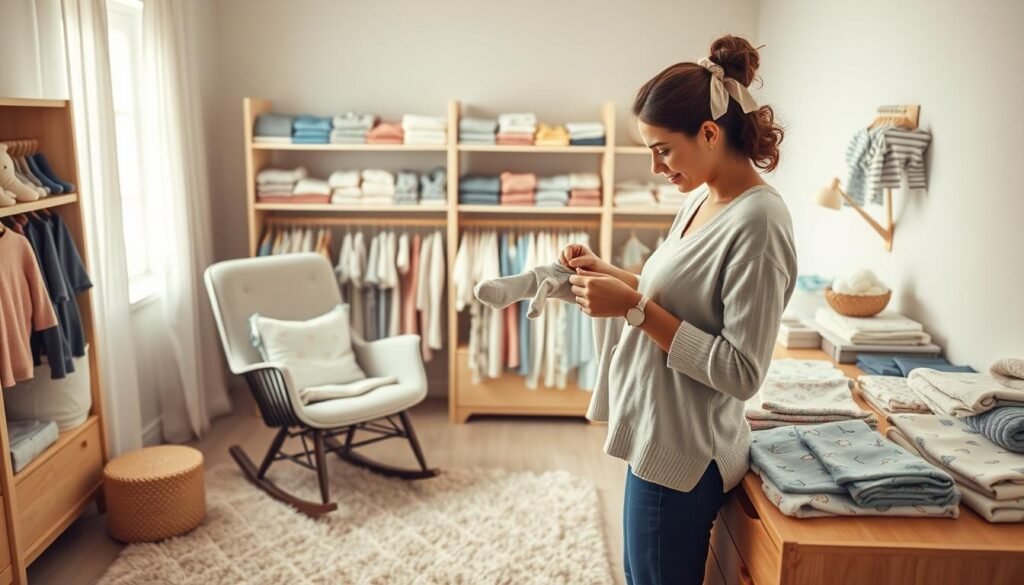
In-Store vs. Online Shopping
Shopping in stores lets you feel the clothes. You can check if they fit right and are comfy. It’s also good to look at the stitching and fabric for quality.
Online, you can see more styles and brands. You can compare prices and read what other parents say. Sites like Carter’s and Nordstrom have size charts and reviews to help you choose.
Reading Labels and Tags
Understanding clothes labels is key. Labels tell you about the fabric, how to wash them, and the size. Organic cotton is great for babies with sensitive skin.
Look at the age and weight guidelines on tags. Newborn sizes fit babies 5-8 lbs and 17-21 inches. Clothes with stretch or adjustable parts last longer as your baby grows.
Setting Up Your Baby’s Wardrobe
Setting up a baby’s wardrobe can be both exciting and daunting. We aim to make it easier by identifying key baby wardrobe essentials. We also offer tips for organizing baby clothes for different sizes and seasons. Below, we’ll provide guidelines to ensure your baby is comfortably and stylishly outfitted through all stages of growth.
Essential Items for Each Size
Keeping track of what your baby will need at each stage is crucial for effective baby apparel planning. For newborns, here are the recommended quantities:
- 10-15 onesies
- 7-10 pants/leggings
- 7-10 sleepers
- 6 singlets
- 2-3 cardigans or jackets
- 3 cotton bunny rugs
- 2 cotton hats
- A few pairs of socks
Many babies grow rapidly, often outgrowing newborn sizes within weeks. It’s wise to invest in size 0-3 months and later sizes. For the first year, here are some essentials:
- 0-3 months: Onesies, pants/leggings, sleepers, soft hat + socks (if winter)
- 3-6 months: Onesies, pants/leggings/shorts/skirt, sleepers, winter gear, socks
- 6-9 months: Onesies, jeans, sleepers, winter gear, socks, shoes
- 9-12 months: Onesies, jeans/pants, pajamas, winter hat
Organizing by Size and Season
An organized wardrobe can significantly ease the daily hassle of dressing your baby. Here are some tips for organizing baby clothes by size and season:
- Group clothes by size: Arrange clothes in the closet or drawers according to size ranges – start with 0-3 months, then 3-6 months, and so on.
- Seasonal sorting: For each size category, segregate clothes based on the weather—keep summer and winter outfits separated.
- Keep frequent changes in mind: Babies often need at least one change of clothes per day, so keep essentials like onesies and sleepers within easy reach.
- Label storage bins: Use labeled storage bins for off-season clothes or for sizes that your baby will grow into later.
Remember, practicality should always trump impulse buying. Regularly assess your baby’s wardrobe to ensure optimal comfort and utility.
Considerations for Fabric and Material
Choosing the right fabric for baby clothes is key. It affects both comfort and function. We suggest soft, breathable materials like cotton for baby’s skin. Knowing the different baby fabric types helps us pick the best.
Comfort and Functionality
Comfortable baby clothes are made from natural fibers. Cotton and bamboo are top choices because they are soft and breathable. Let’s see why they’re so good:
- Softness: Cotton and bamboo are super soft, making babies comfy all day.
- Breathability: These fabrics let air in, which helps avoid rashes and irritation.
- Hypoallergenic: Bamboo is great for sensitive skin because it’s hypoallergenic.
- Durability: Cotton is durable, making it a smart choice for clothes that get washed a lot.
Functionality
Functional baby apparel should be easy to clean and last long. Bamboo is a great example. It’s soft, breathable, and durable. It’s perfect for keeping babies comfy.
It’s also good to think about eco-friendly options. Organic materials like GOTS-certified organic cotton are growing in popularity. They’re safer for babies and better for the planet.
| Fabric Type | Features | Benefits |
|---|---|---|
| Cotton | Breathable, Soft, Durable | Ideal for sensitive skin, reduces irritation |
| Bamboo | Hypoallergenic, Breathable, Moisture-Wicking | Keeps baby dry, reduces skin allergies |
| Wool | Insulating, Natural Fiber | Provides warmth, good for layering |
By picking the right *baby fabric types*, we keep our little ones happy and comfy. Quality and suitability are key. They greatly affect our babies’ well-being.
Common Issues and How to Solve Them
Dealing with baby clothes can feel like solving a puzzle. Issues like clothes growing too small, shrinking after washing, and different sizes in brands can be frustrating. But, there are ways to solve these problems.
To solve sizing issues, buy clothes a size bigger than your baby’s current age. Babies grow out of clothes every 3-4 months. So, buying bigger clothes means they last longer. Also, following washing instructions can stop clothes from shrinking too much. Different fabrics react differently to washing, so always check the care labels.
Being flexible with your baby’s clothes is another good tip. Brands have different size standards. Trying out different brands helps find the best fit. This way, your baby stays comfortable and stylish without needing to return clothes often.
About 30% of parents buy clothes that are too small in the first year. Using online size charts, which 60% of parents prefer, helps a lot. It’s important to measure your baby regularly, as they grow fast.
Comfort is key! Choose clothes with adjustable waistbands or stretchy fabrics. About 70% of parents like clothes that grow with their baby. This makes clothes last longer and keeps your baby comfortable.
Being proactive helps a lot with baby clothes issues. Keep a size log and watch for size changes. This helps make better choices. About 50% of parents struggle with size changes, but tracking your baby’s growth makes it easier.
Conclusion
We’ve looked into baby clothes sizing to help you understand it better. You now know how age, weight, and length affect sizing. Our guide makes it easy to pick the right size, from newborn to 0-3 months.
We also talked about different sizing labels, like European and U.S. sizes. We showed how to convert between them. This helps when buying clothes for any age baby. Remember, having the right amount of clothes is key, like 10-14 pajamas for the first months.
Our guide also stresses the importance of comfortable and functional clothes. Choosing the right fabrics and fit is crucial for your baby’s comfort and growth. Watch for signs it’s time to change sizes, like tight clothes or limited movement. With these tips, you can create a wardrobe that’s both stylish and practical for your baby at every stage!
FAQ
How are baby clothes sized?
Baby clothes are sized by age, from newborn to 24 months and beyond. But, age-based sizing doesn’t always match a child’s size perfectly.
What are the critical factors in choosing the correct baby clothes size?
Age, weight, and length are key. Knowing these helps avoid clothes that are too big or too small.
How do I use a baby clothes size chart effectively?
Size charts guide you on sizes versus age, weight, and length. Start with these charts and adjust based on your baby’s fit and growth.
Do baby clothes sizes vary between brands?
Yes, sizes can differ a lot between brands. Some brands may be larger or smaller. It’s good to try on clothes when you can.
What are the common sizing standards for baby clothes in the U.S.?
In the U.S., sizes include ‘Preemie,’ ‘Newborn,’ ‘3 months,’ and more. These sizes match certain weight and height ranges. But, growth rates can vary.
What should I know about newborn baby clothes sizes?
Newborn sizes fit babies up to 8 pounds and 21.5 inches long. Many newborns grow out of these sizes fast, needing 0-3 months size soon.
How do baby clothes sizes by weight work?
Sizes range from ‘Preemie’ (under 5 pounds) to toddler sizes over 30 pounds. This helps as the child grows.
What factors should I consider when choosing the right size for my baby?
Think about your baby’s growth, brand sizes, and the type of clothes. Trying different sizes and adjusting based on use and comfort is key.
How do European baby clothes sizes differ from U.S. sizes?
European sizes are in centimeters, for the baby’s length. Guides help convert these to U.S. sizes like 70, 80, and 90 centimeters.
What are the advantages of shopping for baby clothes in-store vs. online?
In-store shopping lets you try clothes on. Online shopping offers more variety. Knowing labels and fabrics is important for a good fit.
How should I organize my baby’s wardrobe?
Organize with essentials for each growth stage. Include daily wear, seasonal clothes, and special outfits. Organizing by size and season helps manage clothes well.
Why is the choice of fabric important in baby clothes?
Fabric affects comfort and function. Choose soft, breathable materials like cotton. Also, think about how easy they are to clean and how durable they are.
What are common issues with baby clothes and how can they be solved?
Issues include growing out of clothes fast, clothes shrinking after washing, and size differences between brands. Buy slightly larger sizes, follow washing instructions, and stay flexible with your wardrobe.


